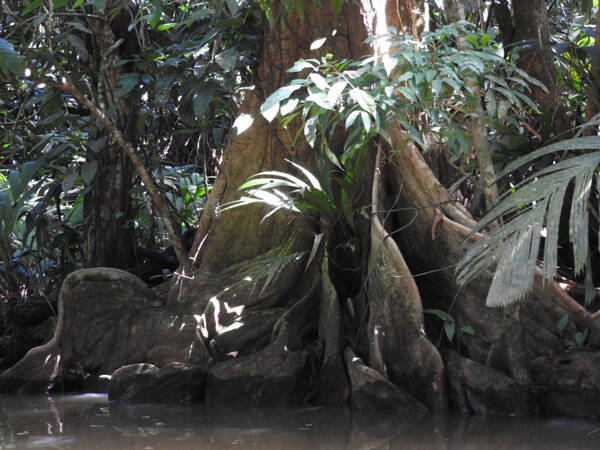News & Articles
Browse all content by date.


We waited to board the bus that first morning with the effervescent attitude of vacation. This was probably the least responsibility any of us had ever held for a trip. Someone else was managing the logistics, translating instructions, and worrying over details. Our responsibility seemed mainly to be on time and have fun. We reacted like a case of soda bottles suddenly opened and relieved of their pressure: little bubbles of happiness danced up toward the surface, popping and splattering a fine mist of joy over everything.
Later, on our drive back from the first lodge at Tortugero, our guide Jimmy announced that we’d be returning for lunch to the same spot we’d eaten our first day’s breakfast. It was the place we’d observed the sloths. A hearty cheer rose spontaneously from the group. Jimmy thereafter referred to the restaurant “as that place you don’t like so much,” and we responded with laughter every single time.
So, yes, even the humor in Costa Rica translated well.
We really didn’t struggle with any cultural shock—once folks got into the habit of putting toilet paper in the waste basket and became comfortable drinking the water on their national system. Secretly, I did struggle with natural shock: it’s not often I travel to a place where I can’t spout a constant (or even intermittent) stream of facts about the flora and fauna. Jimmy did a great job, but I still missed teaching.
Since returning, though, I’ve made time to read a resource I bought used online. “A Neotropical Companion,” by John C. Kricher was written in 1989, but still provides a nice overview of rainforest ecology. The fun part is that many of his facts remind me of things right here at home.
For instance, Kricher described the “typical tropical tree” as having wide buttressed roots flaring out from the base of its trunk. They provide excellent support for the tree, especially since deep tap roots aren’t needed to access water. Our very own black ash trees also have shallow, spreading roots to provide stability in their swampy habitats. Seasonal forest ponds are often marked by ash trees with flared bases.
The shallow, spreading roots that are characteristic of tropical trees are an essential part of their nutrient cycle. With so much rain, most rainforest soils have had the minerals leeched out of them. Available minerals come mostly from efficient recycling within the forest. Shallow roots serve to catch and hold nutrients from quickly decomposing leaf litter. Despite the thick, abundant leaves in the rainforest, the ground in Costa Rica reminded me of an earthworm-infested forest back home. Night crawlers aren’t native to the Northwoods, and they decompose the duff too quickly for many native species’ liking.
Roots in the tropics are so shallow that some of them even grow UP onto the stems of neighboring trees, and they may being trying to intercept minerals washing down the tree trunk. Orchids and other epiphytes (epiphytes are “air plants” that grow up in the trees) grow baskets of wiry roots that can trap organic matter and allow fungi to decompose it into soil. The orchids use that soil as a source of nutrients and water, of course, but the tree may also sprout aerial roots to draw nutrients out of its own canopy.
While epiphytes and air roots aren’t common in the Northwoods, those roots and the roots of almost every plant on Earth rely on mycorrhizal fungi in order to access enough water and nutrients. The term “wood wide web” had yet to be coined in 1989, but Kricher already knew about the importance of fungal mycelia for capturing nutrients and feeding a forest. In the rainforest system, algae also live in the root mat and act as an additional sponge to capture nutrients before they can escape.
Not all compounds are retained in the forest system, though. Plants on poor soils create longer-lasting leaves in order to conserve resources (up here, the plants in bogs come to mind). Durable leaves must be heavily armed against pathogens and predators. When those leaves finally fall, they can’t be decomposed until their defense chemicals have been washed away. It’s those tannins that turn rivers dark. “Blackwater” rivers in Costa Rica are tinted by the same chemicals as the Black River in Wisconsin.
My list of connections goes on. Forest succession, bird adaptations, even the eating habits of howler monkeys remind me of things here at home in the Northwoods. Now it also works in reverse: when people from the trip run into each other, we reminisce about jokes we told and the things we saw in Costa Rica.
I love how connections rise to the surface and splatter a fine mist of joy over everything.
Emily’s book, Natural Connections: Exploring Northwoods Nature through Science and Your Senses is here! Order your copy at http://cablemuseum.org/natural-connections-book/. Listen to the podcast at www.cablemusum.org!
For 50 years, the Cable Natural History Museum has served to connect you to the Northwoods. Come visit us in Cable, WI! Our new exhibit: “Better Together--Celebrating a Natural Community” is now open!
| Tweet |


